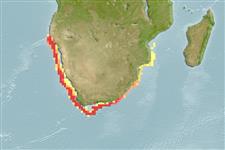>
Gadiformes (Cods) >
Merlucciidae (Merluccid hakes)
Etymology: Merluccius: Latin, mar, maris = the sea + Latin, lucius = pike (Ref. 45335).
Environment: milieu / climate zone / depth range / distribution range
Sinh thái học
Biển Tầng đáy biển sâu; không di cư; Mức độ sâu 200 - 1000 m (Ref. 6605), usually 400 - ? m (Ref. 58452). Deep-water; 17°S - 38°S, 10°E - 48°E (Ref. 58452)
Southeast Atlantic: Cape Frio, Namibia south to the Agulhas Bank and east to East London in South Africa. Western Indian Ocean: Madagascar Ridge (33°S,44°E).
Length at first maturity / Bộ gần gũi / Khối lượng (Trọng lượng) / Age
Maturity: Lm 47.8 range ? - ? cm
Max length : 115 cm TL con đực/không giới tính; (Ref. 27121); common length : 60.0 cm SL con đực/không giới tính; (Ref. 1371)
Các tia vây lưng cứng (tổng cộng) : 1; Các vây lưng mềm (tổng cộng) : 42 - 50; Tia cứng vây hậu môn: 0; Tia mềm vây hậu môn: 38 - 41. Body more slender than other hakes. Head large, about 25 to 30% of SL. Gill rakers short and thick with blunt tips. Pectoral fin tips reaching to level of anal fin origin. Color is steel gray on back, grading to silvery white ventrally.
Found near the bottom. Feeds on fishes, mysids, euphausiids and squids. Young feed mainly on euphausiids, but the diet becomes polyphagous with growth. Cannibalism has been observed in larger individuals (Ref. 9583).
Life cycle and mating behavior
Maturities | Sự tái sinh sản | Spawnings | Egg(s) | Fecundities | Ấu trùng
Cohen, D.M., T. Inada, T. Iwamoto and N. Scialabba, 1990. FAO species catalogue. Vol. 10. Gadiform fishes of the world (Order Gadiformes). An annotated and illustrated catalogue of cods, hakes, grenadiers and other gadiform fishes known to date. FAO Fish. Synop. 125(10). Rome: FAO. 442 p. (Ref. 1371)
IUCN Red List Status (Ref. 130435)
Threat to humans
Harmless
Human uses
Các nghề cá: tính thương mại cao
Các công cụ
Special reports
Download XML
Các nguồn internet
Estimates based on models
Preferred temperature (Ref.
123201): 6.2 - 12, mean 7.5 °C (based on 17 cells).
Phylogenetic diversity index (Ref.
82804): PD
50 = 0.5000 [Uniqueness, from 0.5 = low to 2.0 = high].
Bayesian length-weight: a=0.00525 (0.00348 - 0.00791), b=3.09 (2.96 - 3.22), in cm total length, based on LWR estimates for this species & Genus-body shape (Ref.
93245).
Mức dinh dưỡng (Ref.
69278): 4.9 ±0.2 se; based on diet studies.
Thích nghi nhanh (Ref.
120179): thấp, thời gian nhân đôi của chủng quần tối thiểu là 4.5 - 14 năm (K=0.09-0.12).
Fishing Vulnerability (Ref.
59153): High to very high vulnerability (65 of 100).
Climate Vulnerability (Ref.
125649): High vulnerability (55 of 100).
Nutrients (Ref.
124155): Calcium = 7.36 [3.59, 25.05] mg/100g; Iron = 0.274 [0.058, 0.735] mg/100g; Protein = 17.3 [16.1, 18.5] %; Omega3 = 0.146 [0.078, 0.273] g/100g; Selenium = 28 [13, 66] μg/100g; VitaminA = 11.7 [2.4, 55.4] μg/100g; Zinc = 0.186 [0.127, 0.288] mg/100g (wet weight);
